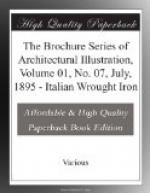* * * * *
Mr. Frank Miles Day and Mr. R.W. Gibson, each in his own way, described the advantages of foreign travel and the best methods to pursue, as well as the most important ends to be attained.
Mr. Russell Sturgis, in a scholarly paper upon the subject of Greek architecture applied to modern buildings, gave a number of precepts for the proper use of Greek forms and methods of building as applied to our modern conditions. He closed his article with a lot of receipts much in the style of an architectural cook book, for the application of his theories concerning Greek architecture.
These articles, as will be seen from the above indications, dealt in most cases with one phase only of architectural education. They are all of course important in their way, as contributing to the general discussion of the subject, but each in turn gives only a partial view.
* * * * *
Mr. Marshall, however, starts with the intention of making a full and fair statement of existing conditions and logically draws his inferences as to the best methods of meeting them. He has the valuable qualification of being able to consider his subject judicially and of writing excellent and readable English, as has already been pointed out in these columns, in the review of his recently published book, “AEsthetic Principles.”
He divides the subject for convenience into three main headings: first, the use of tools, including in his classification the executive function of handling men as well as tools in the narrower and legitimate sense; second, the nature of materials employed; and third, the general principles of beauty. Under the first heading Mr. Marshall makes one important suggestion, which is at variance with common practice among architects. After pointing out the importance of studying design in the solid, that is, constantly keeping in mind that the forms which are to be designed have three dimensions, and that a geometrical projection, such as a plan or elevation, only partially represents its appearance, he advocates the more general use of perspective drawing in designing. By this is not meant the making of pretty sketches after the design is all determined, to mislead impressionable clients, but the serious study of a design to determine its appearance from different points of view. In fact his suggestion is that the usual order of proceeding shall be reversed, and that the design shall be made in perspective and then translated into accurate terms of such geometrical projections as are needed to guide the practical workman in carrying out the work.
In treating of materials Mr. Marshall takes up separately the materials of construction and the materials of design, meaning by the latter the vocabulary in which the architect expresses his ideas, or the accumulation of architectural forms making up the various historic styles, so-called. He emphasizes the importance—in which point he agrees with all the other writers above referred to—of a wide and catholic knowledge of architectural history and a careful study of all styles.




